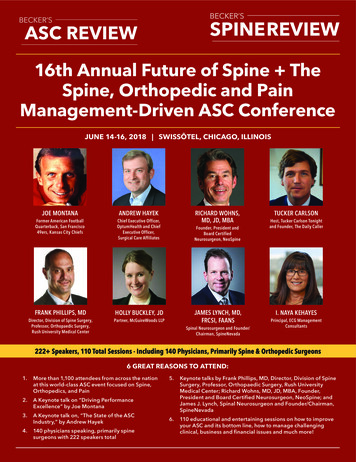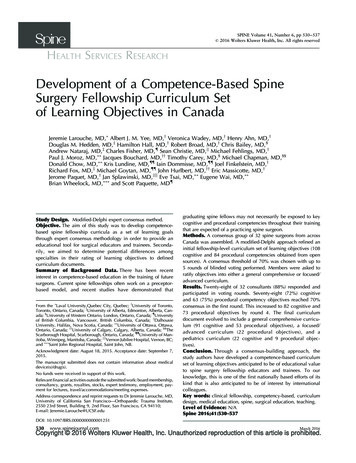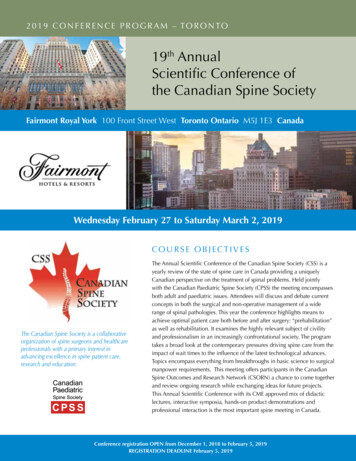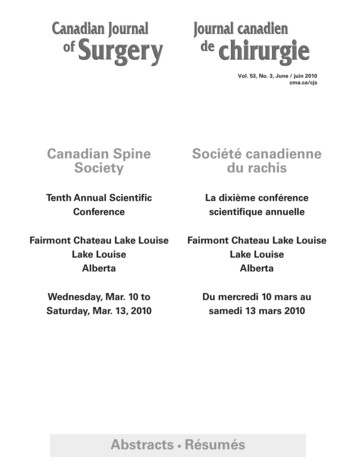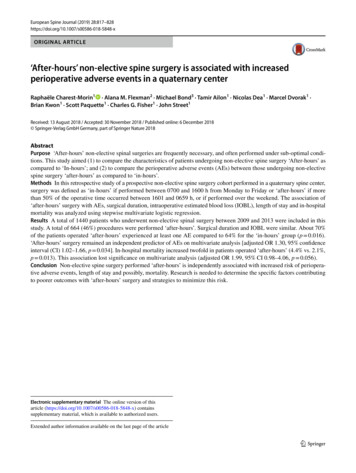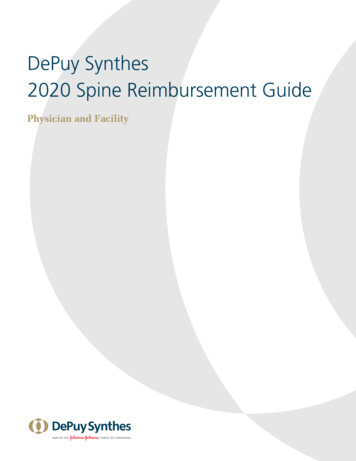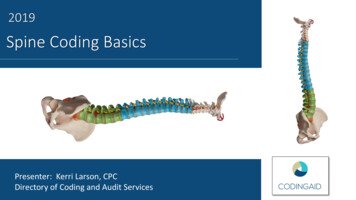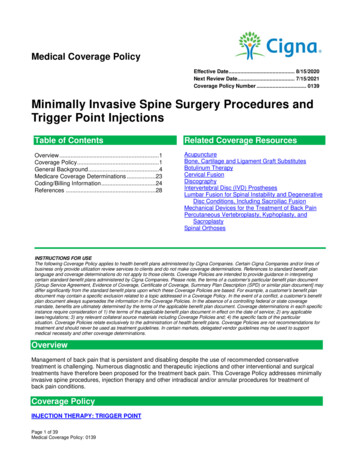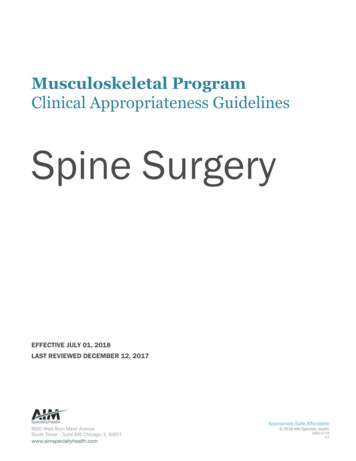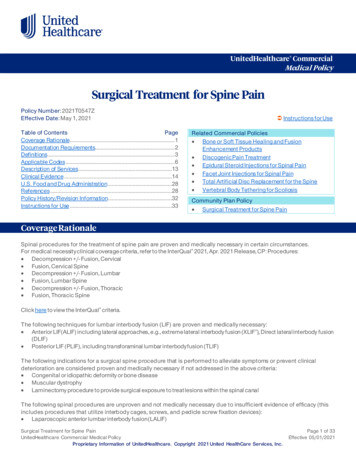
Transcription
UnitedHealthcare CommercialMedical PolicySurgical Treatment for Spine PainPolicy Number: 2021T0547ZEffective Date: May 1, 2021Table of ContentsPageCoverage Rationale. 1Documentation Requirements. 2Definitions. 3Applicable Codes . 6Description of Services.13Clinical Evidence .14U.S. Food and Drug Administration.28References .28Policy History/Revision Information.32Instructions for Use .33 Instructions for UseRelated Commercial Policies Bone or Soft Tissue Healing and FusionEnhancement Products Discogenic Pain Treatment Epidural Steroid Injections for Spinal Pain Facet Joint Injections for Spinal Pain Total Artificial Disc Replacement for the Spine Vertebral Body Tethering for ScoliosisCommunity Plan Policy Surgical Treatment for Spine PainCoverage RationaleSpinal procedures for the treatment of spine pain are proven and medically necessary in certain circumstances.For medical necessity clinical coverage criteria, refer to the InterQual 2021, Apr. 2021 Release, CP: Procedures: Decompression /- Fusion, Cervical Fusion, Cervical Spine Decompression /- Fusion, Lumbar Fusion, Lumbar Spine Decompression /- Fusion, Thoracic Fusion, Thoracic SpineClick here to view the InterQual criteria.The following techniques for lumbar interbody fusion (LIF) are proven and medically necessary: Anterior LIF(ALIF) including lateral approaches, e.g., extreme lateral interbody fusion (XLIF ), Direct lateral interbody fusion(DLIF) Posterior LIF (PLIF), including transforaminal lumbar interbody fusion (TLIF)The following indications for a surgical spine procedure that is performed to alleviate symptoms or prevent clinicaldeterioration are considered proven and medically necessary if not addressed in the above criteria: Congenital or idiopathic deformity or bone disease Muscular dystrophy Laminectomy procedure to provide surgical exposure to treat lesions within the spinal canalThe following spinal procedures are unproven and not medically necessary due to insufficient evidence of efficacy (thisincludes procedures that utilize interbody cages, screws, and pedicle screw fixation devices): Laparoscopic anterior lumbar interbody fusion (LALIF)Surgical Treatment for Spine PainUnitedHealthcare Commercial Medical PolicyProprietary Information of UnitedHealthcare. Copyright 2021 United HealthCare Services, Inc.Page 1 of 33Effective 05/01/2021
Transforaminal lumbar interbody fusion (TLIF) which utilizes only endoscopy visualization (such as a percutaneous incisionwith video visualization)Axial lumbar interbody fusion (AxiaLIF )Interlaminar lumbar instrumented fusion (ILIF) utilizing an interspinous process fusion deviceSpinal decompression and interspinous process decompression systems for the treatment of lumbar spinal stenosis (e.g.,Interspinous process decompression (IPD), Minimally invasive lumbar decompression (mild )Spinal stabilization systemso Stabilization systems for the treatment of degenerative spondylolisthesiso Total facet joint arthroplasty, including facetectomy, laminectomy, foraminotomy, vertebral column fixationo Percutaneous sacral augmentation (sacroplasty) with or without a balloon or bone cement for the treatment of backpainStand-alone facet fusion without an accompanying decompressive procedures; this includes procedures performed with orwithout bone grafting and/or the use of posterior intrafacet implants such as fixation systems, facet screw systems or antimigration dowelsFor information on vertebral body tethering, see the Medical policy titled Vertebral Body Tethering for Scoliosis.Documentation RequirementsBenefit coverage for health services is determined by the member specific benefit plan document and applicable laws that mayrequire coverage for a specific service. The documentation requirements outlined below are used to assess whether themember meets the clinical criteria for coverage but do not guarantee coverage of the service requested.CPT Codes*Surgical Treatment for Spine Pain22100, 22101, 22102,22110, 22112, 22114,22206, 22207, 22210,22212, 22214, 22220,22224, 22532, 22533,22534, 22548, 22551,22552, 22554, 22556,22558, 22585, 22586,22590, 22595, 22600,22610, 22612, 22614,22630, 22632, 22633,22634, 22800, 22802,22804, 22808, 22810,22812, 22818, 22819,22830, 22840, 22841,22842, 22843, 22844,22845, 22846, 22847,22848, 22849, 22850,22852, 22853, 22854,22855, 22859, 22899,63001, 63003, 63005,63011, 63012, 63015,63016, 63017, 63020,63030, 63035, 63040,63042, 63043, 63044,63045, 63046, 63047,63048, 63050, 63051,63055, 63056, 63057,63064, 63066, 63075,Required Clinical InformationMedical notes documenting the following, as applicable: Condition requiring procedure History and co-morbid medical condition(s)o Smoking history/status, including date of last smoking cessation Member’s symptoms, pain, location, and severity including functional impairment that isinterfering with activities of daily living (meals, walking, getting dressed, driving) Failure of Conservative Therapy through lack of clinically significant improvement betweenat least two measurements, on a validated pain or function scale or quantifiable symptomsdespite concurrent Conservative Therapies (see definition), if applicable Progressive deficits with clinically significant worsening based on at least twomeasurements over time, if applicable Surgical history, including date(s) and outcome(s) Progressive deficits with clinically significant worsening based on at least twomeasurements over time, if applicable Disabling Symptoms, if applicable Upon request, we may require the specific diagnostic image(s) that show the abnormalityfor which surgery is being requested, which may include MRI, CT scan, X-ray, and/or bonescan; consultation with requesting surgeon may be of benefit to select the optimal imageso Note: When requested, diagnostic image(s) must be labeled with: The date taken Applicable case number obtained at time of notification, or member's name and IDnumber on the image(s)o Upon request, diagnostic imaging must be submitted via the external portal atwww.uhcprovider.com/paan; faxes will not be accepted Diagnostic image(s) report(s) , including presence or absence of:o Segment (s) instabilityo Spinal cord compressiono Disc herniationo Nerve root compressionSurgical Treatment for Spine PainUnitedHealthcare Commercial Medical PolicyProprietary Information of UnitedHealthcare. Copyright 2021 United HealthCare Services, Inc.Page 2 of 33Effective 05/01/2021
CPT Codes*Required Clinical InformationSurgical Treatment for Spine Pain63076, 63077, 63078,o Quantification of subluxation, translation by flexion, angulation when appropriate63081, 63082, 63085,o Discitis63086, 63087, 63088,o Epidural abscess63090, 63091, 63101, Physical exam, including neurologic exam, including degree and progression of curvature63102, 63103, 63170,(for scoliosis), if applicable63172, 63173, 63185,o Degree and progression of curvature (for scoliosis)63190, 63191, 63194,o Quantification of relevant muscle strength63195, 63196, 63197, Whether the surgery will be performed with direct visualization or only with endoscopic63198, 63199, 63200,visualization63250, 63251, 63252, Complete report(s) of diagnostic tests, including:63265, 63266, 63267,o Results of biopsy(ies)63268, 63270, 63271,o Results of bone aspirate63272, 63275, 63277, Describe the surgical technique(s) planned [e.g., AxialLIF , XLIF, ILIF, OLIF, LALIF, imageguided minimally invasive lumbar decompression (mild ), percutaneous endoscopic63280, 63282, 63285,63286, 63287, 63290,discectomy with or without laser, etc.]63300, 63301, 63302,63303, 63304, 63305,63306, 63307, 63308.*For code descriptions, see the Applicable Codes section.DefinitionsAnterior Lumbar Spine Surgery: Performed by approaching the spine from the front of the body using a traditional frontmidline incision (i.e., through the abdominal musculature and retroperitoneal cavity) or by lateral approaches from the front sideof the body (e.g., eXtreme lateral interbody fusion [XLIF]; direct interbody fusion [DLIF]; oblique interbody fusion [OLIF]).Arthrodesis: A surgical procedure to eliminate motion in a joint by providing a bony fusion. The procedure is used for severalspecific purposes: to relieve pain; to provide stability; to overcome postural deformity resulting from neurologic deficit; and tohalt advancing disease.Axial Lumbar Interbody Fusion (AxiaLIF): Also called trans-sacral, transaxial or para-coccygeal interbody fusion is a minimallyinvasive technique used in L5-S1 (presacral) spinal fusions. The technique provides access to the spine along the long axis ofthe spine, as opposed to anterior, posterior or lateral approaches. The surgeon enters the back through a very small incisionnext to the tailbone and the abnormal disc is taken out. Then a bone graft is placed where the abnormal disc was and issupplemented with a large metal screw. Sometimes, additional, smaller screws are placed through another small incisionhigher on the back for extra stability. (Cragg, et al., 2004)Conservative Therapy: Consists of an appropriate combination of medication (i.e., NSAIDs, analgesics, etc.) in addition tophysical therapy, spinal manipulation therapy, cognitive behavioral therapy (CBT) or other interventions based on theindividual’s specific presentation, physical findings and imaging results. (AHRQ 2013; Qassem 2017; Summers 2013)Corpectomy: Removal of all or part of a vertebral body. For vertebral corpectomy, the term partial is used to describe removalof a substantial portion of the body of the vertebra. In the cervical spine, the amount of bone removed is defined as at least onehalf of the vertebral body. In the thoracic and lumber spine, the amount of bone removed is defined as at least one-third of thevertebral body (AMA CPT book 2021).Direct Lateral Interbody Fusion (DLIF): Uses a similar approach as XLIF. During a direct lateral or extreme lateral approach, anarrow passageway is created through the underlying tissues and the psoas muscle using tubular dilators, without cutting themuscle; which is the major difference between the open approach and lateral approach. The interbody device and bone graftare inserted via the tubular dilator. In some cases, it is necessary to remove part of the iliac crest. The procedure is generallyindicated for interbody fusion at the lower levels of the spine (e.g., L1-L5 levels) and is considered a modification to the lateralSurgical Treatment for Spine PainUnitedHealthcare Commercial Medical PolicyProprietary Information of UnitedHealthcare. Copyright 2021 United HealthCare Services, Inc.Page 3 of 33Effective 05/01/2021
retroperitoneal approach utilized for other spinal surgery and an alternative to posterior lumbar interbody fusion (PLIF),transforaminal lumbar interbody fusion (TLIF).Disabling Symptoms: Are defined in a pivotal study demonstrating benefit of surgery (Weinstein, 2009) where the participantswith an Oswestry Disability Index score of more than 8, or an SF-36 Bodily Pain Score of less than 70 or a Physical FunctionScore of less than 78 were the ones that demonstrated benefit. These scores are equal to or more severe than the majority ofparticipants, meaning those participants within two standard deviations ( /-) of the mean for such scores.Dynamic Stabilization: Also known as soft stabilization or flexible stabilization has been proposed as an adjunct or alternativeto spinal fusion for the treatment of severe refractory pain due to degenerative spondylolisthesis, or continued severe refractoryback pain following prior fusion, sometimes referred to as failed back surgery syndrome. Dynamic stabilization uses flexiblematerials rather than rigid devices to stabilize the affected spinal segment(s). These flexible materials may be anchored to thevertebrae by synthetic cords or by pedicle screws. Unlike the rigid fixation of spinal fusion, dynamic stabilization is intended topreserve the mobility of the spinal segment.Facet Arthroplasty: The implantation of a spinal prosthesis to restore posterior element structure and function, as an adjunct toneural decompressionFacet Fusion: A minimally invasive back procedure that uses specially designed bone dowels made from allograft material(donated cortical bone) that are inserted into the facet joints. The procedure is designed to stop facet joints from moving and isintended to eliminate or reduce back pain caused by facet joint dysfunction (Gellhorn, 2013).Facet Syndrome: A condition in which arthritic change and inflammation occur and the nerves to the facet joints convey severeand diffuse pain.Image-Guided Minimally Invasive Lumbar Decompression (mild ): A percutaneous procedure for decompression of thecentral spinal canal in individuals with lumbar spinal stenosis. In this procedure, a specialized cannula and surgical tools areused under fluoroscopic guidance for bone and tissue sculpting near the spinal canal. (Vertos Medical, 2018)Interlaminar Lumbar Instrumented Fusion (ILIF): During the ILIF procedure, the surgeon makes an incision in the lower backand an opening is created through the ligaments. This allows access to the spinous processes. The bone, ligament or disc thatis causing compression is removed to release pressure on the nerves. Allograft bone may be placed in the disc space. Bone,either autograft and/or allograft, is placed between the spinous processes and on the remaining lamina. An implant is insertedto stabilize the spine and secure the spinous processes until the fusion takes place.Interlaminar Stabilization Device: An implantable titanium interspinous process device (IPD) that reduces the amount oflumbar spinal extension possible while preserving range of motion in flexion, axial rotation, and lateral bending. Coflex is a Ushaped device with 2 pair of serrated wings extending from the upper and lower long arms of the U. The U portion is insertedhorizontally between 2 adjacent spinous processes (bones) in the back of the spine, and the wings are crimped over bone tohold the implant in place. The device is implanted after decompression of stenosis at the affected level(s). (Paradigm Spine,2013)Interspinous Process Decompression (IPD): Minimally invasive surgical procedure used to treat lumbar spinal stenosis whenconservative treatment measures have failed to relieve symptoms. IPD involves surgically implanting a spacer between one ortwo affected spinous processes of the lumbar spine. After implantation the device is opened or expanded to distract (open) theneural foramen and decompress the nerves. Spacers are implanted midline between adjacent lamina and spinous processes toprovide dynamic stabilization following decompressive surgery. IPD is purported to block stenosis-related lumbar extensionand, thus, relieve associated pain and allow resumption of normal posture.Laparoscopic Anterior Lumbar Interbody Fusion (LALIF): Minimally invasive alternative to an open surgical approach to spinalfusion. The vertebrae are reached through an incision in the lower abdomen or side. This method employs a laparoscope toremove the diseased disc and insert an implant (i.e., rhBMP, autogenous bone, cages or fixation devices) into the disc spaceintended to stabilize and promote fusion.Surgical Treatment for Spine PainUnitedHealthcare Commercial Medical PolicyProprietary Information of UnitedHealthcare. Copyright 2021 United HealthCare Services, Inc.Page 4 of 33Effective 05/01/2021
Lumbar Spinal Stenosis (LSS): Narrowing or constriction of the lumbar spinal canal that may result in painful compression of anerve and/or blood vessel(s) supplying the nerve.Neurogenic Claudication (also known as pesudoclaudication): A common indicator of lumbar spinal stenosis caused by aninflamed nerve coming from the spinal column. Symptoms include the sensation of pain in the buttock, thigh, or leg orweakness in the legs that is relieved with a change in position or leaning forward and improves with rest. (Ammendolia, 2014)Note: Neurogenic claudication should be differentiated from vascular claudication.Percutaneous or Endoscopic Lumbar Fusion: During a percutaneous endoscopic procedure the surgeon does not havedirect visualization of the operative field, in contrast to an open approach. Visual guidance is obtained using either fluoroscopyor a video monitor. Specialized instruments are typically used and advanced through a retractor, avoiding major soft tissueinjury. The approach is associated with a steep learning curve, risk of radicular trauma with insertion of cages, and in somecases postoperative migration of the devices.Posterior Lumbar Spine Surgery: Is performed by approaching the spine through the individual’s back by a traditional backmidline incision or transforaminally through the opening between two spinal vertebrae (i.e., the foramen) where the nerves leavethe spinal canal to enter the body (i.e., transforaminal lumbar interbody fusion [TLIF]).Progressive: Significant worsening of deficits or symptoms based on at least two measurements over days or weeks (rapidlyprogressive) or over months (progressive) on a validated pain or function scale or quantifiable symptoms.Radicular Pain: Pain which radiates from the spine into the extremity along the course of the spinal nerve root. The pain shouldfollow the pattern of a dermatome associated with the irritated nerve root identified. (Lenahan, 2018) Presenting symptoms should include a positive nerve root tension sign (positive straight leg raise test or femoral tensionsign), or a reflex (asymmetric depressed reflex), sensory (asymmetric decreased sensation in a dermatomal distribution), ormotor (asymmetric weakness in a myotomal distribution) deficit that correspond to the specific affected nerve root.(Birkmeyer, 2002) As surgery is meant to relieve radicular pain from nerve root compression, imaging should show compression of thecorresponding nerve root.Sacroplasty: A minimally invasive surgical treatment that attempts to repair sacral insufficiency fractures using bone cement.Sacral insufficiency fractures have traditionally been treated with conservative measures, including bed rest, analgesics,orthoses/corsets and physical therapy. In some cases pain persists, and is refractory to these measures. For this procedure, 2thin, hollow tubes are placed in the lower back, over the left half and right half of the sacrum, guided by images from x-rays orcomputed tomography scans. The surgeon then advances a needle through each tube to the site of the sacral fracture andinjects 2 to 5 mL of bone cement. (Hayes, 2018)Spinal Fusion: Also called arthrodesis, is a surgical technique that may be done as an open or minimally invasive procedure.There are many different approaches to spinal fusion, but all techniques involve removing the disc between two or morevertebrae and fusing the adjacent vertebrae together using bone grafts and/or spacers placed where the disc used to be.Spacers can be made of bone or bone substitutes, metal (titanium), carbon fiber, polymers or bioresorbable materials and areoften supported by plates, screws, rods and/or cages.Spinal Stabilization: These spinal devices are fixed in place using pedicle screws which are attached to the vertebral bodiesadjacent to the intervertebr
of a substantial portion of the body of the vertebra. In the cervical spine, the amount of bone removed is defined as at leas t one - half of the vertebral body. In the thoracic and lumber spine, the am ount of bone removed is defined as at le
